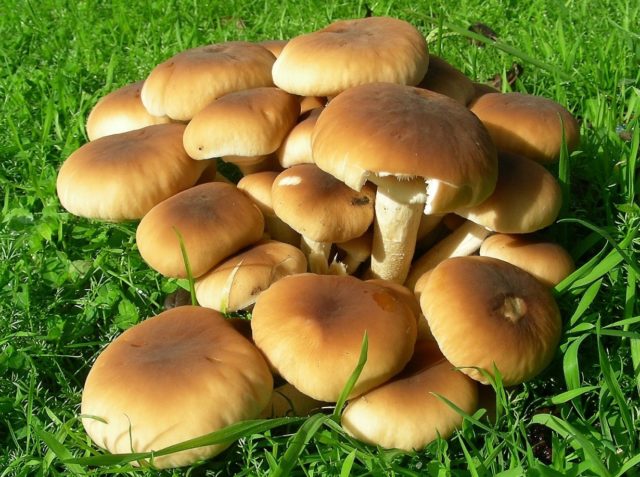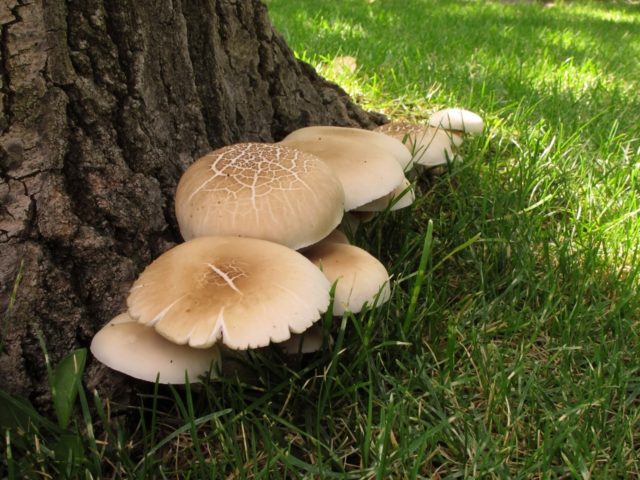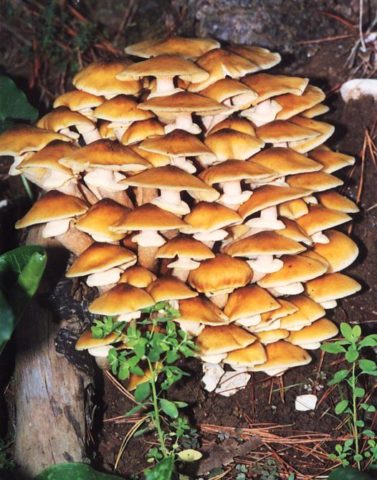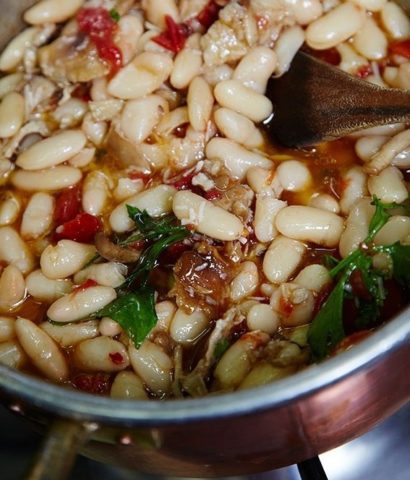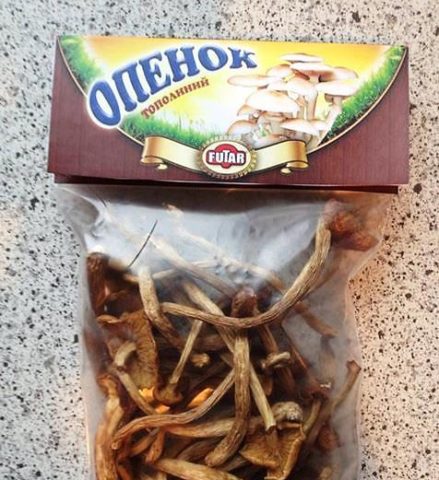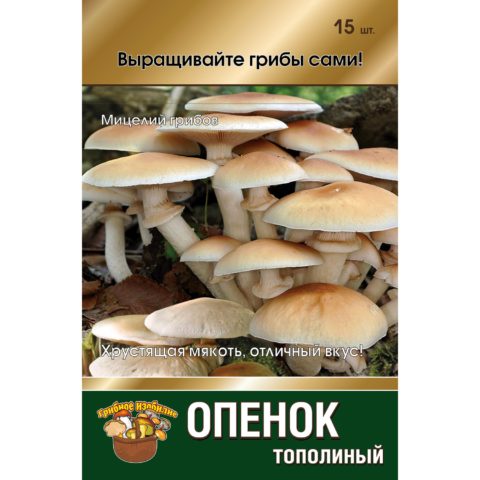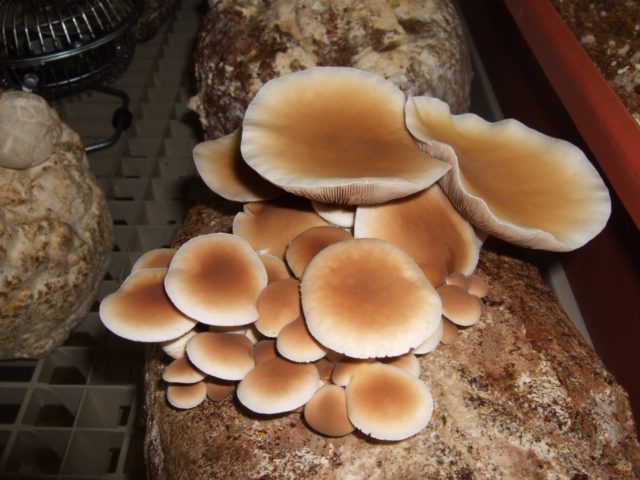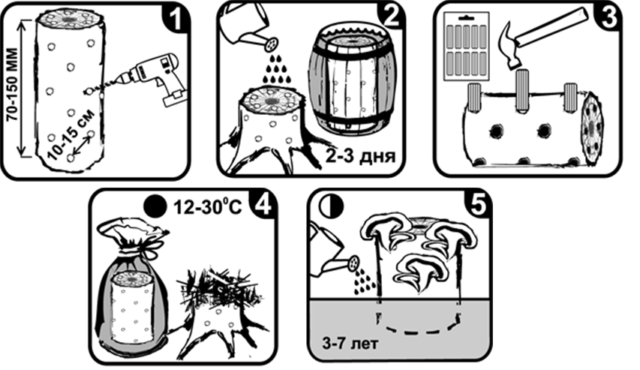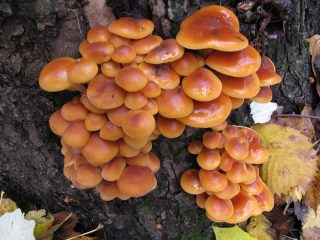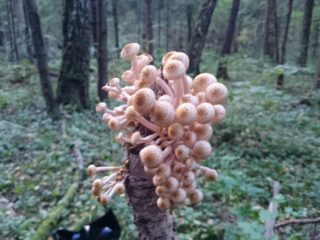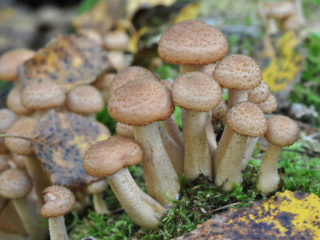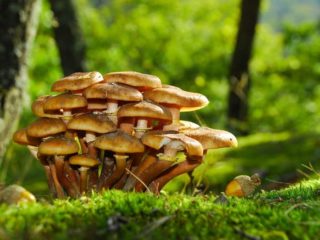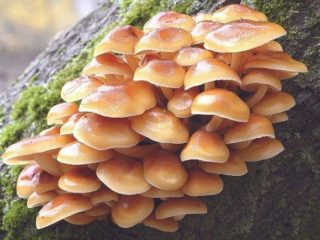Content
Poplar honey mushroom has been considered a delicacy mushroom since the time of the Roman Empire. It has a unique rich taste. The use of the poplar tree has a positive effect on the human body. This unpretentious mushroom can be grown on its own.
What does poplar mushroom look like?
Poplar honey fungus (Cyclocybe aegerita) is a cultivated mushroom cultivated since ancient times. Its synonymous names are used: pioppino, poplar agrocybe (Agrocybe aegerita), poplar foliot (Pholiota aegerita).
Description of the hat
The cap of young fruiting bodies of poplar honey agaric is round, velvety, brownish in color with a diameter of 5 - 7 cm. In mature specimens, it takes on flatter outlines, brightens and becomes covered with shallow cracks. The edges of the cap are wavy. The color and texture of its surface can vary, depending on the climatic and weather conditions of the growing area.
The plates of the fungus are thin, wide, narrowly accrete. They are light-colored: white or yellowish, but with age they become fawn, almost brown.
The flesh of the mushroom is thin, cotton-like, fleshy. When cooked, it has a crunchy texture. It is characterized by a white or light color, with a brown undertone. The spore powder of these mushrooms is brown.
Leg description
The cylindrical stem of poplar honey fungus, up to 15 cm in diameter, can reach 3 cm. It is slightly swollen and has a central position relative to the cap. There is a clear border between the parts of the fruiting body, along which the stem breaks off easily. The surface of the leg is smooth and silky. Its pulp has a fibrous structure. Almost under the cap itself there is a flap-shaped ring. It is clearly visible. In a mature specimen, the brownish ring contrasts with the light color of the fruiting body. The described signs of poplar mushrooms are visible in the photo.
Poplar mushrooms are edible or not
Agrocybe is an edible mushroom with high gastronomic properties. They are specially grown due to the pleasant wine smell and mealy taste of the béchamel sauce. Spicy mushroom and nutty notes remain in the aftertaste.
How to cook poplar mushrooms
The collected poplar mushrooms have a short shelf life, no more than 20 hours. In a purified frozen form, they are stored for 5 - 6 days, including the day of collection. For this reason, mushrooms are rarely found commercially. Farmers supply poplar agrocybe directly to restaurants, where soups, sauces, and julienne are prepared from them. They complement the Italian and French cuisine.
Beans with poplar mushrooms - an old Neapolitan recipe. To prepare this dish, you will need:
- 500 g white beans;
- 250 g of mushroom raw materials;
- 1 head of onion;
- 150 g cherry tomatoes;
- 6 tbsp olive oil;
- parsley and basil to taste;
- salt pepper.
Cooking method:
- The beans are washed and boiled until tender.
- Honey mushrooms are cleaned, simmer for 10 minutes. over low heat.
- Fry the onion until golden brown in olive oil, remove from the pan.
- Mushrooms and tomatoes cut into 4 pieces and stew in the same oil for about 7 minutes.
- Add beans to the pan and add the water in which it was cooked. The dish is simmered for about 3 minutes.
- Remove from heat, add herbs and spices.
The healing properties of poplar mushrooms
The use of poplar mushrooms has a beneficial effect on the human body. They have the following useful properties:
- Poplar mushrooms contain the amino acid methionine, which is not produced in the human body, but is necessary to normalize blood cholesterol levels, reduce the deposition of neutral fat in the liver and improve its function. This substance, due to the activation of the synthesis of adrenaline, has a moderate antidepressant effect.
- The product is distinguished by its bactericidal properties. On the basis of substances isolated from the fruit bodies, the antibiotic agrocybin was synthesized, which has strong antibacterial and antifungal activity.
- Lectin obtained from poplar honey is capable of inhibiting the development of cancer cells.
Application in traditional medicine
Traditional healers advise using poplar honey for chronic headaches. Dishes from them are included in the diet for dietary meals with high blood pressure. In order not to provoke stagnation of fluid in the body, hypertensive patients should not eat salted or pickled mushrooms.
Where and how it grows
Poplar agrocybe is widespread in southern Europe. It grows naturally from July to September on dead and living deciduous trees. Most often, this type of honey fungus is found on poplars and willows. It can be found on fruit trees, birches, elderberry, elm, where it bears fruit en masse in the form of numerous clusters.
When cultivated on an industrial scale and in the household, poplar honey fungus is grown on stumps, logs or wood chips. They also form massive druses under controlled conditions.
In Russia, the mushroom is grown only as a cultivated species. There is no data on its distribution in natural conditions.
Growing poplar honey agarics on the site or in the country
To grow the variety on the site, you will need mycelium, which can be purchased at a specialty store. It is planted on wooden sticks made of poplar, measuring 8x35 mm.
To get a good harvest of mushrooms, the following algorithm of actions is recommended for planting and growing them:
- Choose a wood into which honey agarics will be inoculated. For these mushrooms, stumps or logs of deciduous trees with a diameter of at least 15 cm are suitable.No more than 4 months should pass from the moment of their cutting. For 2 - 3 days, the logs are soaked in water, and the stumps are watered abundantly. If the saw cut was less than 1 month. back, no pre-soaking is required.
- Prepare holes for sticks with mycelium. To do this, on the day of planting, the selected log is sawn into workpieces 30-50 cm long.Around the perimeter and in the end parts, holes with a diameter of at least 1 cm are drilled in a checkerboard pattern (at least 20 in the log, 40 times in the stump).
- Wood is inoculated. It is best to inoculate stumps in the spring, and logs in 2 - 6 months. before placing in the ground. To place the mycelium in the wood, with clean hands, remove the sticks from the bag and insert them all the way into the holes, which are then sealed with beeswax or plasticine.Important! Inoculation is the procedure for introducing live fungi into a nutrient medium.
- Leave the log to grow in a cool, damp place, such as a basement or shed. At an air temperature of 22 - 25 0With and a relative humidity of 85 - 90%, it will take 2 - 3 months to overgrow the holes. To speed up the process, the inoculated preform is pre-packed in a black perforated bag. The stumps are covered with straw or burlap, they are well moistened and do not allow it to dry out. If the inoculation was carried out in August-September, then the logs can be placed in the ground immediately after the procedure, without overgrowing.
- Overgrown logs are planted in the soil. They are placed in open ground from April to September. Planting blanks in closed containers can be carried out throughout the year. The site should be shaded with soil that retains moisture well. The log is buried 1/2 or 1/3 part into a shallow trench, at the bottom of which wet leaves, sawdust or straw are laid.
Poplar mushrooms planted in this way will bear fruit from spring to mid-November for 3 to 7 years, depending on the size and density of the blanks. On soft wood, fruiting lasts 3 - 4 years, on dense wood - 5 - 7 years. The maximum yield is reached in the 2nd - 3rd year.
In order for the mycelium to bear fruit abundantly and for a long time, it is necessary to maintain its constant humidity. In dry hot weather, the land around it is irrigated with a drip method. After harvesting, watering is stopped. After one to two weeks, it is renewed. In summer, the mycelium must be protected from direct sunlight. For the winter, it is covered with earth or dry leaf.
For growing poplar honey agaric, flower pots are used. They are filled with mulch or poplar sawdust. Wood blanks are deepened into the ground by 8 - 10 cm. Such plantings give 2 - 3 harvests per year.
Another way to grow poplar honey agaric is presented in the video.
Doubles and their differences
On the territory of Russia, poplar honey fungus is specially grown in a controlled environment. It has striking characteristics, and it is almost impossible to confuse it with other varieties.
Conclusion
Poplar honey mushroom is a delicious mushroom. At home, it can be grown outdoors on a log or indoors on sawdust. Subject to the simple rules of care, the mycelium bears fruit for up to 7 years.
